Intel Xeon E-2276G Benchmarks
For this exercise, we are using our legacy Linux-Bench scripts which help us see cross-platform “least common denominator” results we have been using for years as well as several results from our updated Linux-Bench2 scripts. At this point, our benchmarking sessions take days to run and we are generating well over a thousand data points. We are also running workloads for software companies that want to see how their software works on the latest hardware. As a result, this is a small sample of the data we are collecting and can share publicly. Our position is always that we are happy to provide some free data but we also have services to let companies run their own workloads in our lab, such as with our DemoEval service. What we do provide is an extremely controlled environment where we know every step is exactly the same and each run is done in a real-world data center, not a test bench.
We are going to show off a few results, and highlight a number of interesting data points in this article.
Python Linux 4.4.2 Kernel Compile Benchmark
This is one of the most requested benchmarks for STH over the past few years. The task was simple, we have a standard configuration file, the Linux 4.4.2 kernel from kernel.org, and make the standard auto-generated configuration utilizing every thread in the system. We are expressing results in terms of compiles per hour to make the results easier to read:

As you can see, we have a relatively more constrained set of comparison points, but that set still encompasses sixteen socket-compatible variants for servers. Here, even with only 6 cores and two-channel memory, we see the Xeon E-2276G perform almost on part with the 8-core Intel Xeon Silver 4208 which is a great result.
c-ray 1.1 Performance
We have been using c-ray for our performance testing for years now. It is a ray tracing benchmark that is extremely popular to show differences in processors under multi-threaded workloads. We are going to use our 8K results which work well at this end of the performance spectrum.
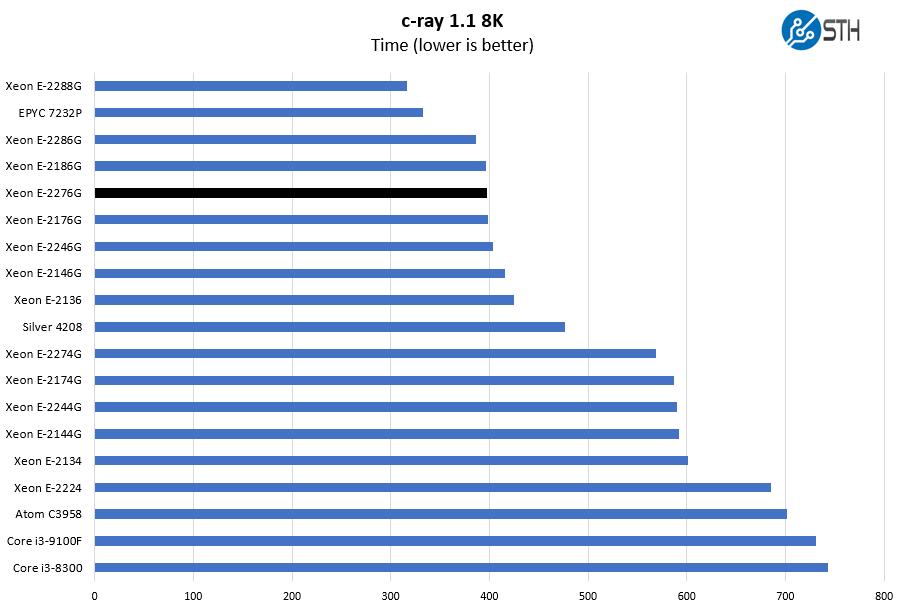
We see a lot of the six core variants look close together on this chart, with the exception of the Intel Xeon E-2286G which pulls ahead by a small but notable margin.
7-zip Compression Performance
7-zip is a widely used compression/ decompression program that works cross-platform. We started using the program during our early days with Windows testing. It is now part of Linux-Bench.
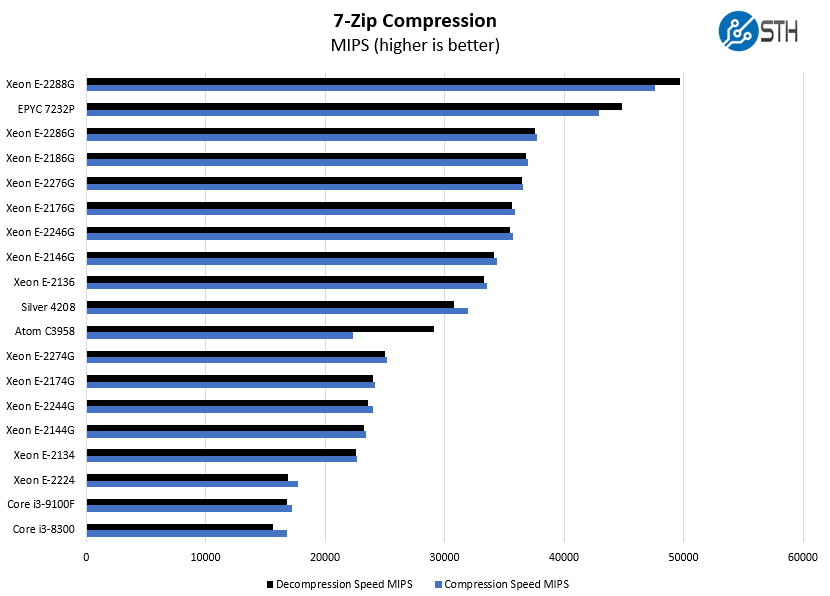
On the compression side, we see the Xeon E-2276G fall just below the Xeon E-2186G. That is important. Usually, we have seen the update generation part slightly surpass the one SKU up the stack model in this segment. At this point, you are starting to see the trend that the Xeon E-2186G seems to be holding a slight advantage even though the delta is very small.
NAMD Performance
NAMD is a molecular modeling benchmark developed by the Theoretical and Computational Biophysics Group in the Beckman Institute for Advanced Science and Technology at the University of Illinois at Urbana-Champaign. More information on the benchmark can be found here. We are going to augment this with GROMACS in the next-generation Linux-Bench in the near future. With GROMACS we have been working hard to support Intel’s Skylake AVX-512 and AVX2 supporting AMD Zen architecture. Here are the comparison results for the legacy data set:
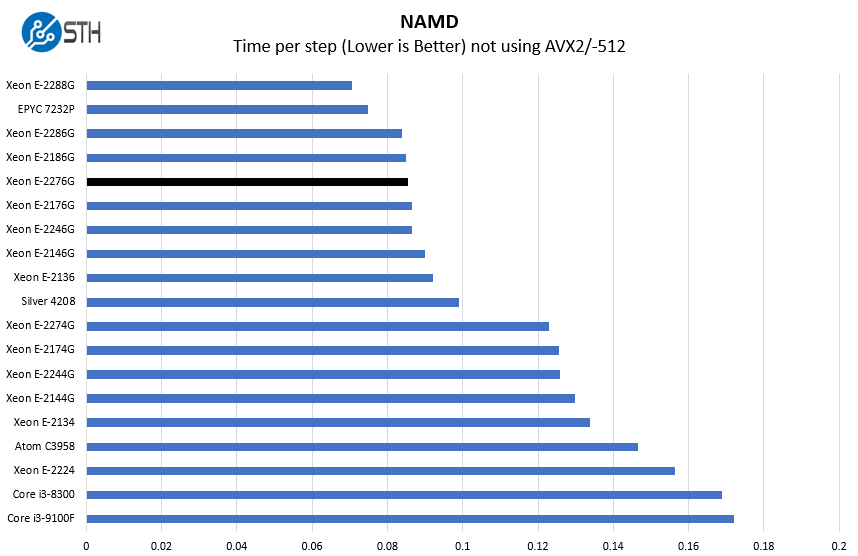
We can see a slight gain over the Intel Xeon E-2176G. This is showing clear generational improvement which you will see on every chart.
Sysbench CPU test
Sysbench is another one of those widely used Linux benchmarks. We specifically are using the CPU test, not the OLTP test that we use for some storage testing.

Sometimes, having more cores helps. That is the case here where the lower power and lower clock speed Intel Atom C3958 is able to pull ahead with 10 more cores.
OpenSSL Performance
OpenSSL is widely used to secure communications between servers. This is an important protocol in many server stacks. We first look at our sign tests:

Here are the verify results:
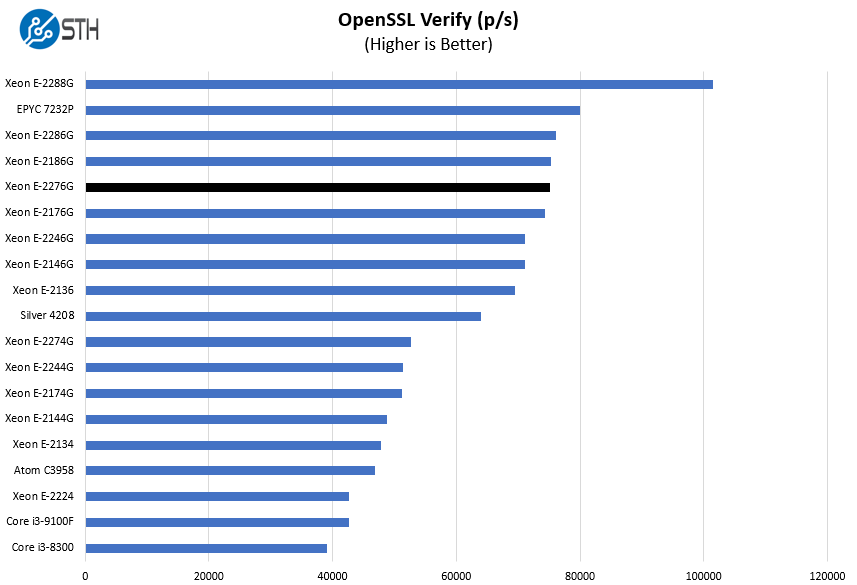
AMD generally does not try to compete in this space, but we did want to point out the AMD EPYC 7232P. The CPU and platform cost a noticeable amount more than the Intel Xeon E-2286G. At the same time, the EPYC 7232P is in a different class in terms of expandability and usually offers better performance. If you simply need expansive connectivity and can push higher consolidation ratios with EPYC, then the price delta will effectively go away.
UnixBench Dhrystone 2 and Whetstone Benchmarks
Some of the longest-running tests at STH are the venerable UnixBench 5.1.3 Dhrystone 2 and Whetstone results. They are certainly aging, however, we constantly get requests for them, and many angry notes when we leave them out. UnixBench is widely used so we are including it in this data set. Here are the Dhrystone 2 results:
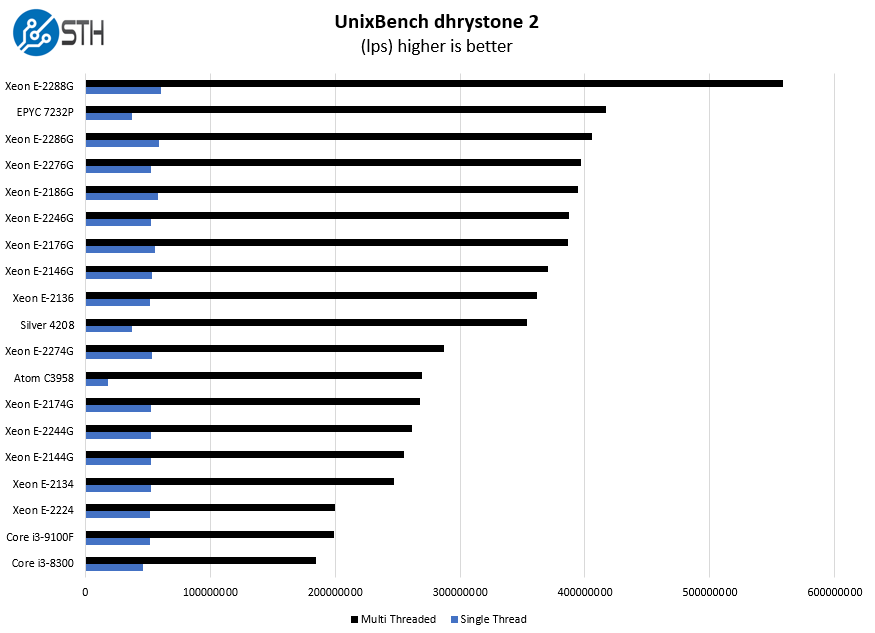
Here are the whetstone results:
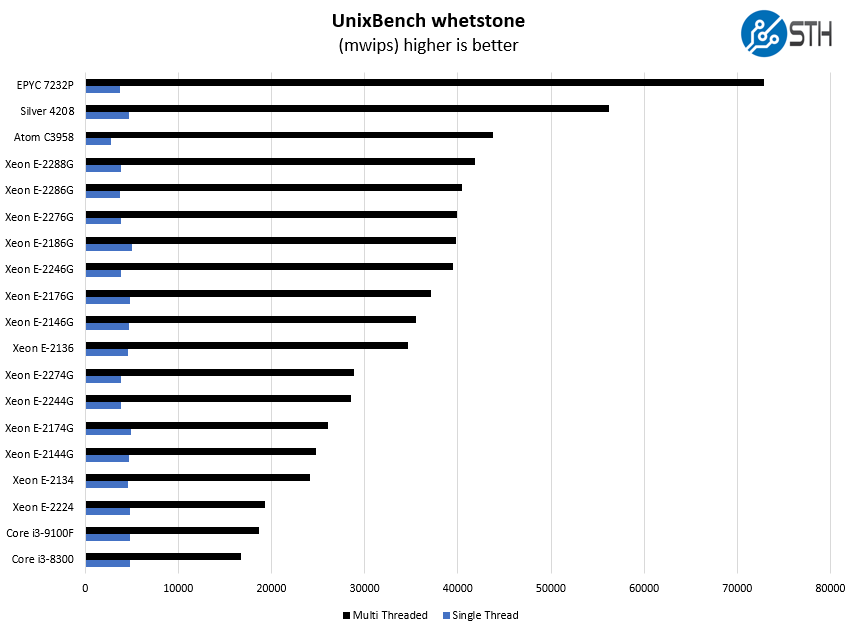
UnixBench is the only result where we saw the Xeon E-2276G perform slightly better than the Xeon E-2186G of the previous generation. We still think that the performance is close enough that price is going to be the bigger factor in purchasing.
GROMACS STH Small AVX2/ AVX-512 Enabled
We have a small GROMACS molecule simulation we previewed in the first AMD EPYC 7601 Linux benchmarks piece. In Linux-Bench2 we are using a “small” test for single and dual socket capable machines. Our medium test is more appropriate for higher-end dual and quad-socket machines. Our GROMACS test will use the AVX-512 and AVX2 extensions if available.

Focusing here on the in-socket results, we wanted to point out the well-defined step function that is taking shape. One can clearly see the 8-core Intel Xeon E-2288G alone at the top. One can also see a quite narrow band with the 6-core offerings. The four core offerings have a larger variation on a percentage basis due to features. In these systems, get the most cores that you can for the amount of money you want to spend.
Chess Benchmarking
Chess is an interesting use case since it has almost unlimited complexity. Over the years, we have received a number of requests to bring back chess benchmarking. We have been profiling systems and are ready to start sharing results:

Here we wanted to point out that the Intel Xeon E-2274G may seem numerically just behind the Xeon E-2276G. In fact, it is in a different league in terms of performance. Conversely, chips like the Intel Xeon E-2136 have a lower numeric value, but are much closer in performance. This all comes down to core counts. The last numeric digit in these parts denotes the number of cores a Xeon E-2200 desktop and/ or server CPU has. Where things get strange is if you look at the Xeon E-2286M we found in the Dell Precision 7540 which has 8 cores despite having a “6” at the end.
We wish Intel would make this consistent across the same product name. Call the mobile version the Xeon M-22xx and give it its own name with M for “Mobile.” The Xeon E for “Entry” makes less sense in the mobile market where there is no real higher-end option such as the Intel Xeon W-3275 or Intel Xeon W-2200 Series.
Next, we are going to have power consumption, market positioning, and our final words.




And some other ones:
Intel last night made public two more data leakage disclosures, which tie back to Zombieload and November’s TAA issue.
Here are the new disclosures:
CVEID: CVE-2020-0548
Description: Cleanup errors in some Intel(R) Processors may allow an authenticated user to potentially enable information disclosure via local access.
CVSS Base Score: 2.8 Low
CVE-2020-0549
Description: Cleanup errors in some data cache evictions for some Intel(R) Processors may allow an authenticated user to potentially enable information disclosure via local access.
CVSS Base Score: 6.5 Medium
CVE-2020-0548 is referred to as Vector Register Sampling and CVE-2020-0549 is going as L1D Eviction Sampling.
A speculative execution side channel variant known as L1D Eviction Sampling may allow the data value of some modified cache lines in the L1 data cache to be inferred under a specific set of complex conditions.
L1D Eviction Sampling is to be mitigated by new CPU microcode updates.
A speculative execution side channel variant known as Vector Register Sampling may allow the partial data values of some vector operations to be inferred under a specific set of complex conditions that include vector operations executing after a period of vector inactivity.
The award for the best use of Lego Minifigs in an IT component review goes to…. John Lee and STH!